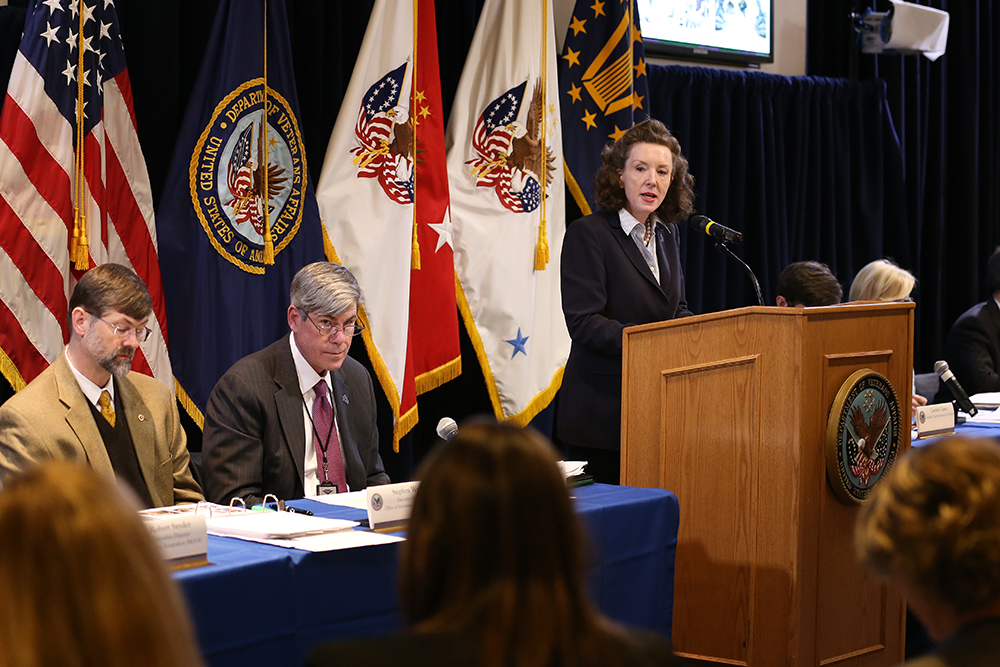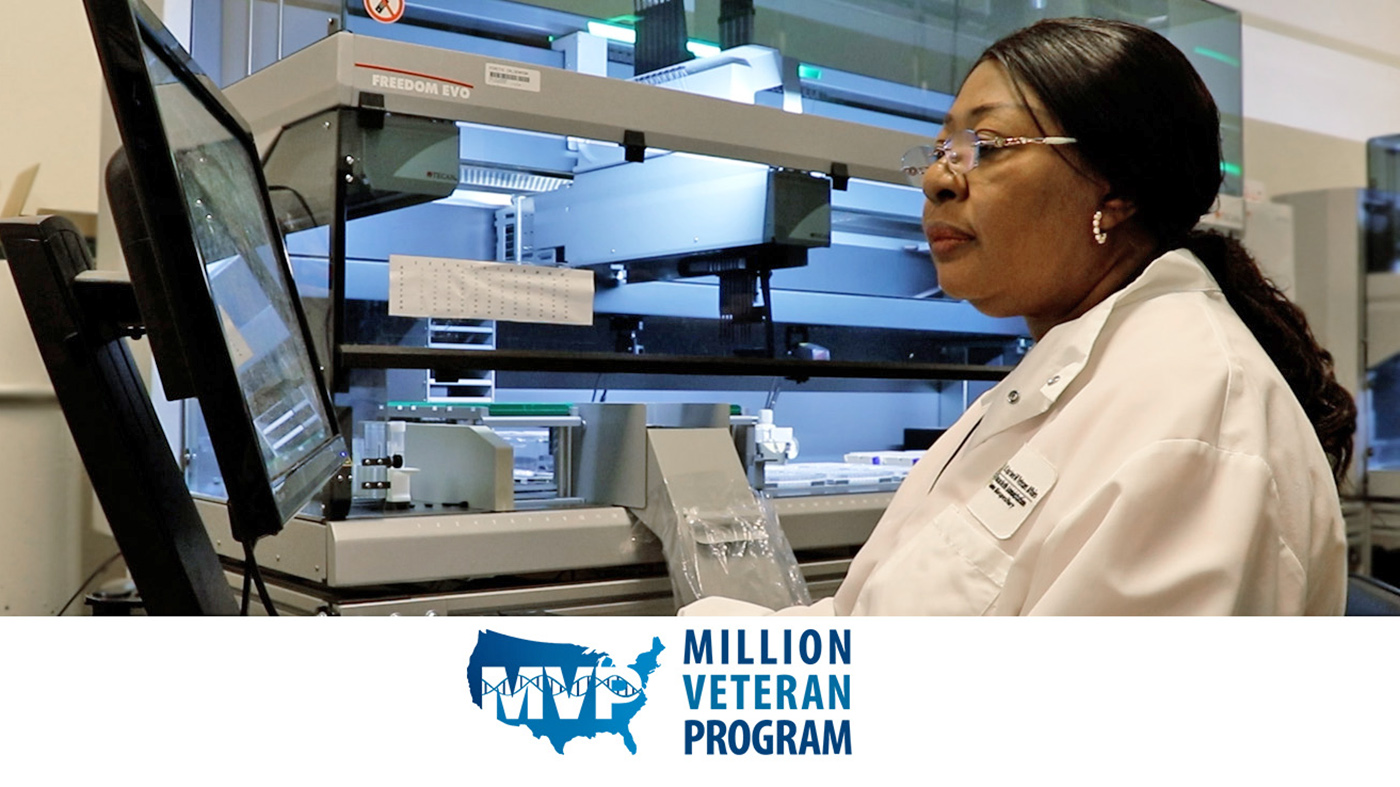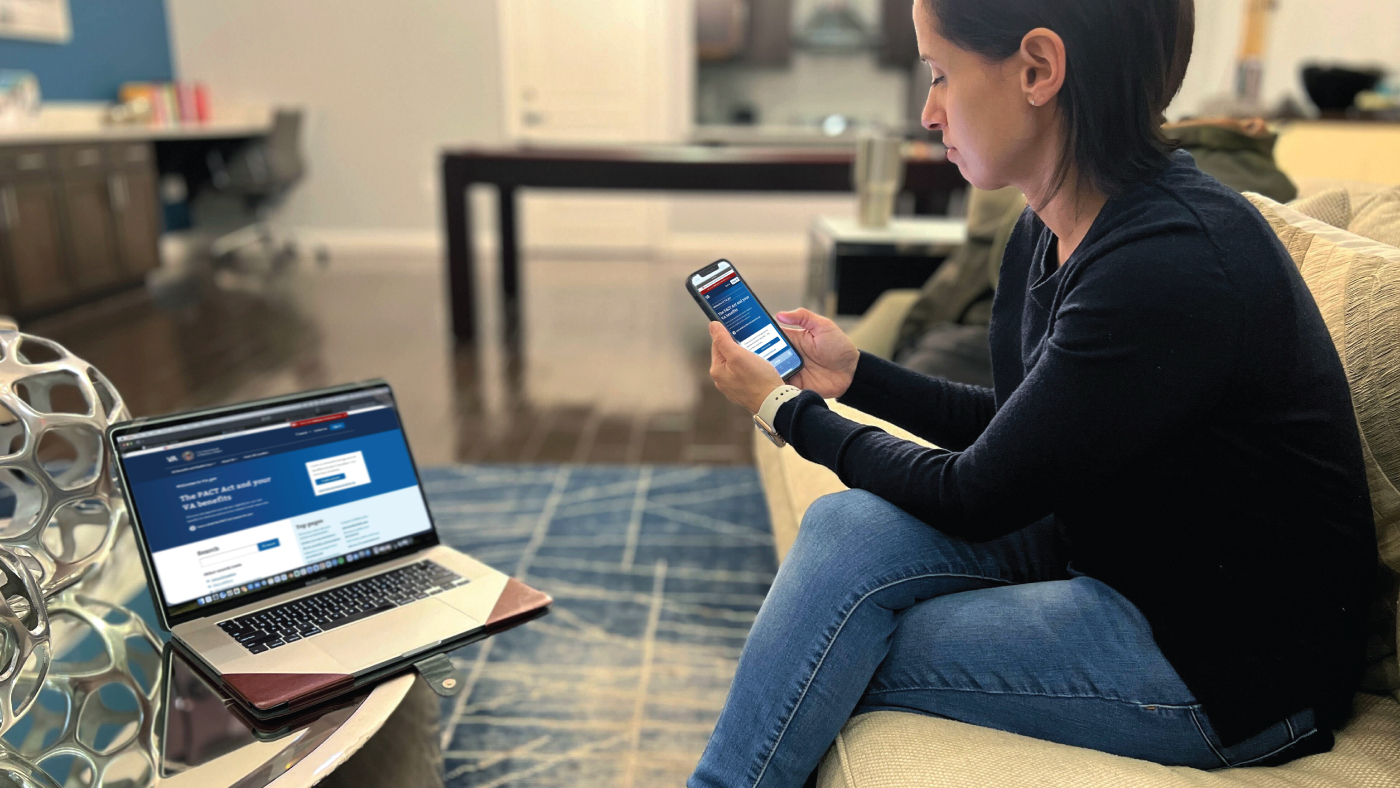The President has proposed a $168.8 billion budget for VA in fiscal year 2016. The proposed budget will support VA goals to expand access to timely, high quality health care and benefits, continue the transformation of VA into a Veteran-centric department and end homelessness among Veterans.
“VA has before it one of the greatest opportunities in its history to enhance care for veterans and build a more efficient and effective system. This budget will allow us to continue important progress to better serve Veterans, their families and their survivors,” said Secretary of Veterans Affairs Bob McDonald. “We are listening to what Veterans, Congress, employees, VSOs, and other stakeholders are telling us. We aspire to make VA a model agency that is held up as an example for other government agencies to follow with respect to customer experience, efficient and effective operations, and taxpayer stewardship.”
The budget includes $73.5 billion in discretionary funding, largely for healthcare, and $95.3 billion for mandatory benefit programs such as disability compensation and pensions. The $73.5 billion total in discretionary spending, including over $3.2 billion in medical care collections from health insurers and Veteran co-payments, is $5.2 billion and 7.5 percent above the 2015 enacted level. The budget also requests $66.6 billion, including collections, for the 2017 advance appropriations for medical care, an increase of $3.4 billion and 5.4 percent above the 2016 medical care budget request. As a first-time request for advance appropriations for 2017 for compensation and pensions, readjustment benefits, and Veterans insurance and indemnities, within our mandatory benefits programs in the Veteran’s Benefits Administration, $104 billion is requested for 2017.
“We remain committed to providing Veterans the opportunity to pursue their education, find meaningful employment and access high-quality health care and earned benefits,” Secretary McDonald added. “From the men and women of ‘the greatest generation’ to the Veterans who have returned from our most recent conflicts in Iraq and Afghanistan, every Veteran deserves to have a seamless, integrated, and responsive VA customer service experience every time.”
However, more resources will be required to ensure that VA can provide timely, high-quality health care into the future. VA is hearing directly from Veterans and their representatives that they would prefer to get their care in VA facilities from the medical professionals they know and with whom they have relationships. In the coming months, the Administration will submit legislation to allow the Department to reallocate a portion of unused funding from the Veterans Choice Program to support essential investments in VA system priorities in a fiscally responsible, budget-neutral manner. This flexibility will allow the department to serve Veterans the way they want and deserve to be served.
VA operates one of the largest integrated health care systems in the country with approximately 9.4 million enrollees; the tenth largest life insurance program; monthly disability compensation, pensions and survivors benefits to more than 5.2 million beneficiaries; educational assistance or vocational rehabilitation benefits and services to 1.2 million students; mortgage guaranties to over 2 million homeowners; and the largest cemetery system in the nation.
Here are highlights from the president’s 2016 budget request for VA.
Health Care
With a medical care budget of $63.2 billion, including collections, VA is positioned to serve approximately 9.4 million veteran patients enrolled to receive care in the fiscal year beginning Oct. 1. The enrollee total includes over 1.4 million Veterans who served in Operation Enduring Freedom/Operation Iraqi Freedom/Operation New Dawn
Major spending categories within the health care budget are:
- $7.5 billion for mental health
- $2.8 billion for prosthetics
- $556 million for spinal cord injuries
- $232 million for traumatic brain injuries
- $243 million for readjustment counseling
- $7.5 billion for long-term care
Expanding Access
The president’s budget would ensure that care and other benefits are available to Veterans when and where they need them. Among the programs that will expand access under the proposed budget are:
- $1.2 billion in telehealth funding, which helps patients monitor chronic health care conditions and increases access to care, especially in rural and remote locations
- $446 million for health care services specifically designed for women, an increase of 8.3 percent over the present level
- $598 million for the activation of new and enhanced health care facilities;
- $1.1 billion for major construction projects
- $86.6 million for improved customer service applications for online self-service portals and call center agent-assisted inquiries
- $5.9 million to bring into full operation two new national cemeteries opening in 2015, and to activate one new national cemetery and one rural National Veterans Burial Ground in 2016
Improving the Efficiency of Claims Processing
The president’s budget provides for full implementation of VBA’s robust transformation plan — a series of people, process, and technology initiatives — in 2016. This plan will continue to systematically improve the quality and efficiency of claims processing and assist the department in processing all disability compensation claims within 125 days.
Major claims transformation initiatives in the budget invest $431 million to bring leading-edge technology to claims processing, including:
- $290 million ($253 million in Information Technology and $37 million in VBA) to support the electronic claims processing system – the Veterans Benefits Management System (VBMS)
- $141 million for Veterans Claims Intake Program to continue conversion of paper records, such as medical records, into electronic images and data in VBMS
In addition, the president’s budget supports rightsizing VBA’s workforce to address staffing needs so it can continue to improve the delivery of benefits to Veterans. As VBA continues to receive and complete more disability compensation rating claims, the volume of appeals, non-rating claims, and fiduciary field examinations correspondingly increases. The request for $85 million for 770 additional full-time equivalent employees will allow VBA to provide more timely actions on appeals and non-rating claims, and will ensure strong fiduciary oversight.
Eliminating Veterans Homelessness
The administration has made the elimination of Veteran homelessness a national priority. The budget request targets $1.4 billion for programs to prevent or reduce homelessness, including:
- $300 million for Supportive Services for Veteran Families (SSVF) to promote housing stability
- $374 million for the HUD-VASH program wherein VA provides case management services for at-risk Veterans and their families and HUD provides permanent housing through its Housing Choice Voucher program
- $201 million in grant and per diem payments that support temporary housing provided by community-based organizations
MyVA
In 2014, Secretary McDonald introduced the MyVA initiative, an effort to reorient the department around the needs of Veterans and make VA a more customer-centric organization. This will ultimately be the largest department-wide transformation in VA’s history and will measure success based on Veteran outcomes and satisfaction. The 2016 budget supports MyVA implementation, which will create a VA that is organized for success from the perspective of Veterans – combining functions, simplifying operations, and proving Veterans the care and services they have earned and deserve.
Veterans Choice Act
The Veterans Choice Act provided $5 billion in mandatory funding to increase Veterans’ access to health care by hiring more physicians and staff and improving the VA’s physical infrastructure. It also provided $10 billion in mandatory funding through 2017 to establish a temporary program (the Veterans Choice Program) improving Veterans’ access to health care by allowing eligible Veterans who meet certain wait-time or distance standards to use eligible health care providers outside of the VA system. The Veterans Choice Program may provide a measure of short-term relief from the pressure of escalating health care needs as current patients in the VA system elect to receive their care through the program. These investments, together with the 2016 budget, will provide the authorities, funding, and other tools to enhance services to veterans in the short-term while strengthening the underlying VA system to better serve veterans in the future. However, more resources in certain areas will be required to ensure that the VA system can provide timely, high-quality health care into the future. In the coming months, the administration will submit legislation to allow the VA secretary to best meet Veteran needs. This will allow the secretary to make essential investments in VA system priorities in a fiscally-responsible, budget-neutral manner.
Other Key Services for Veterans
- $266 million to administer the VA-run system of 133 national cemeteries
- $4.1 billion for information technology (IT), including investments to modernize Veterans’ electronic health records, improve Veterans’ access to benefits, and IT infrastructure
- $1.7 billion in construction, cemetery grants, and extended care grants to include nine VHA major construction projects and four gravesite expansion projects
Topics in this story
More Stories
Seven U.S. Army soldiers, one Army Reserve soldier and two Veterans are representing Team USA at the 2024 Olympic Games in Paris, which begins today.
The findings of this new MVP study underscore the importance and positive impact of diverse representation in genetic research, paving the way for significant advances in health care tailored to Veteran population-specific needs.
VA reduces complexity for Veterans, beneficiaries, and caregivers signing in to VA.gov, VA’s official mobile app, and other VA online services while continuing to secure Veteran data.








Incentives and more incentives! It is more important to figure out the veterans and making sure they receive their due!
…Smoke Screen, still fogging up reality? Care? Come now? VAH hires a 69 year old doctor for our primary care physician…he can not type and do the needed data entry for the appointments! Average appointment time runs over every time and as a patient, I leave totally frustrated with this care, doctor can not listen to veterans medical issues because too busy reading our health history and notes because he just started working for the VAH system 6 months ago. Since 2012, this is the 4th primary care provider in this position. VAH needs to provide quality care to an aging veterans patients needs and not another Rx writer. What choice do we have to go someplace else? None, the ‘choice card’ program is also a media ‘cake icing, because you can not use it without a primary care appointment or referral.’ The blessing here for this veteran is Medicare will soon be an option. Come on with the lies about quality care at the VAH system. Just waiting to die, because change will never come for veterans to get quality, compassionate health care in my lifetime!
This article could really bring in some comments. Brothers and sisters be careful; Freedom of Speech (opinions) is one thing, but to call someone out by name could border on legal issues like slander or defamation of character. I don’t think it would happen here, but you never know.
When an organization is not performing to expectations, management determines whether it is a people problem or a process issue. The VA has both. Although there might be changes which will improve care by a larger budget, one must remember the VA bureaucracy is there for one thing – to perpetuate the bureaucracy.
A way of improving access to health care of veterans, seems to me, is to have an outreach program that will identify veterans who do not have the ability to make contact with the VA facility and to “recruit” these veterans into the system.
This is going into other pockets, it still not helping the veterans it took 1 yr whistle blow to any word from Bob people, senators and congresswomen sat on it know thier cover thier butts . you cccc u can contact ur congressperson/senators, they sit do nothing until a death, this happen in Tomah wi , va try to cover it know , BOB does not care about veterans our congressman/senators don’t CARE pay others to cover help Bob.
Good we need it! No former enlisted serviceman or officer should be without the necessary resources, such that will improve his or her overall quality of life! GOD bless America and GOD bless the President of the United States of America!
Sounds like a good start but at what point do we expand our education of veterans so they know what is available to them? Everyday work day I help veterans or their families apply for their benefits. But we still see a few veterans a week that state things like “I’m not sure I’m a veteran, I wasn’t in combat.”, I’m not sure I am eligible for VA healthcare, I wasn’t injured in combat.”, “I served during WWII and since my Social Security increase were never as big as the cost of living increase I am wondering if the VA pharmacy is less expensive.”. There is no reason for any veteran to not know they are a veteran.
Education in this day and age can be so easy. The electronic reach to gather email address for non-profit organizations, churches, in-home care providers, assisted living, cancer care centers, ALS & Parkinson’s chapters,…or nay group that interacts with veterans has become relatively easy. To educate 10,000 veterans who live in a county takes reaching out to a few hundred non-veteran people who interact with the veterans constantly. Between a monthly radio 1/2 hour, and emails to the church leaders and veteran groups our office is to busy (3 people) to expand our outreach.
It is the pebble theory, drop one stone in the middle of the lake and every inch of the shore will feel it’s effect.
SFC Babcock, THANK YOU! I don’t know what else to say.
This sounds good but I have been hearing on the news about FINANCIAL INCENTIVES for healthcare professionals. Issue this true; and isn’t this at the root of what got the VETERANS Administration in such a mess in the first place? I believe in an honest day’s pay for an honest day’s work. Perhaps the pay scales could be examined instead of bonuses. NO MORE BONUSES!